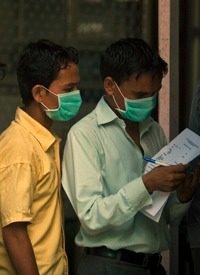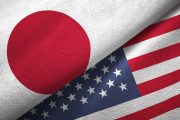
More people die every single day in India from tuberculosis and diarrhea-related diseases than the total number who have perished worldwide from the H1N1 (swine flu) virus since its initial outbreak. Yet the Indian media’s constant focus on H1N1-related deaths, currently in the low 20s for all of India, has people rushing to purchase face masks in a panic that experts say is unjustified.
“Mumbai and New Delhi residents rushed to purchase face masks after India recorded its first swine flu death on Aug. 3, prompting the federal government to advise the general public against buying them and creating a shortage for health-care workers,” Bloomberg reported on August 14. “People intuitively overestimate the risk of rare events and underestimate the risk of common events,” S.J. Habayeb, the World Health Organization’s representative to India, wrote in an e-mail to Bloomberg. “This has happened with the novel H1N1 influenza virus.”
Since the swine flu outbreak began in April, approximately 1,500 people have died after contracting the virus, usually because other factors complicated the situation. According to the most recent WHO figures, these 1,500 represent less than one percent of those who have been infected. Contrast this low lethality with avian influenza, which is fatal in 60 percent of cases.
A 2006 WHO report gives a healthy perspective on how the 1,500 swine flu victims compares to the death toll of other diseases in India. On average, 1,250 people die every day in India from diarrhea-related diseases, and 1,000 perish from tuberculosis. While anyone who catches the H1N1 flu should obviously take it seriously and seek treatment, panicking about the virus is almost laughable in comparison to diseases that kill more people every day than swine flu has in months.
William Aldis, assistant professor of global health at Thailand’s Thammasat University, told Bloomberg by phone that the mortality rate from swine flu “is quite low.” Aldis commented: “It’s such a joke when you compare it to anything else that people choose not to worry about.”
All these facts haven’t stopped officials from overreacting. Mumbai and Pune have closed schools for a time. “What’s the point of closing schools?” said N.K. Pandey, president-elect of the Association of Surgeons in India. “There are thousands of people traveling each day in Mumbai local trains. Is the government going to shut that too?”
U.S. government officials and the U.S. media would do well to learn a lesson from India’s experience. Government officials there have had to ask the Indian media to refrain from scaremongering. Panic serves no purpose but to give government an excuse to exercise its muscles, which of course makes it stronger.
Perhaps that is part of why U.S. officials are so anxious to keep the worst case scenarios in peoples’ minds. If Americans can be convinced that they need government to save them, then they will more easily acquiesce to the cancerous process of making big government even bigger.
Photo: AP Images



